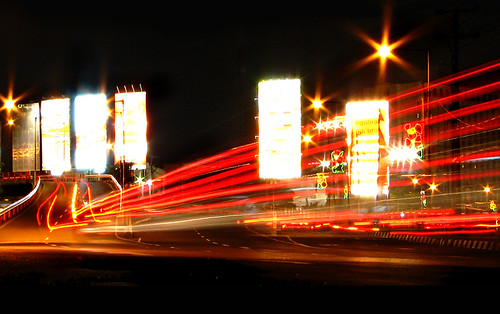Murah ke barang2 kat sana? Yg pastu berjuta2 duit kami bawa dari sini, syukur tak perlu bawa guni untuk duit juta2 tu.. hehehe..


This pic was taken from Jalan Kusuma Bangsa, Surabaya near flyover to Dharmawangsa.
Latar Belakang Surabaya, Indonesia
Source : Wikipedia
Surabaya (formerly Soerabaja) is Indonesia's second-largest city, and the capital of the province of East Java. It is located on the northern shore of eastern Java at the mouth of the Mas River and the side of Madura Strait.
| |||
HISTORY | |||
In the fifteenth and sixteenth century, Surabaya was a sultanate and a major political and military power in eastern Java. It got into a conflict and was later taken by the more powerful Sultanate of Mataram in 1625 under Sultan Agung. It was one of Mataram's fiercest campaigns, where they had to conquer Surabaya's allies, Sukadana and Madura and laid siege to the city before capturing it. With this conquest, Mataram then controlled almost the whole of Java, with the exception of the Sultanate of Banten and the Dutch settlement of Batavia. | |||
It was started after British Brigadier General Mallaby was killed in a car explosion in October 30, 1945 near Jembatan Merah (the "Red Bridge"). The Allies gave an ultimatum to the Indonesian freedom fighters inside the city to surrender, but it was refused. The ensuing battle took place in 10 November. Nowadays celebrated as Heroes' Day (Hari Pahlawan). | |||
THE CITY | |||
| population is around three million, and the surrounding metropolitan area houses at least 5 million. The areas surrounding Surabaya include Lamongan to the northwest, Gresik to the west, Bangkalan to the northeast, Sidoarjo to the south, and Mojokerto and Jombang to the southwest. Currently, the Indonesian government is building the Suramadu Bridge between Surabaya and the island of Madura; when completed, it will be the longest bridge in the country. Madura is currently accessible by a ferry service that operates regularly from Surabaya's port, Tanjung Perak (literally means: "Silver Cape" in Indonesian). Surabaya is home to Eastern Armada, one of two in the Indonesian Navy. Its strong maritime heritage is also reflected with the Submarine Monument, a real retired Russian submarine, called Pasopati, that was converted into a museum ship in the city centre. Flooding is common in many areas of the city during the rainy season, mostly caused by clogged sewers and inept bureaucracy. The fact that Surabaya is located in a river delta and has a flat and relatively low elevation doesn't help the matter either. Surabaya is the location of the only synagogue in Indonesia, although it is currently inactive.[1][2] Surabaya's zoo, opened in 1916, was the first in the world to have successfully bred orangutans in captivity. Other points of interest include:
| |||
DEMOGRAPHY | |||
As the main seaport and commercial center in the eastern region of Indonesia, Surabaya has become one of the largest cities in Southeast Asia. Today, Surabaya's Surabaya is the second most populous city in Indonesia, after Jakarta. Most of its population are of Javanese descent. Notable minorities include Madurese from nearby Madura Island and Chinese Indonesians. | |||







0 comments:
Post a Comment